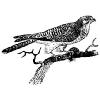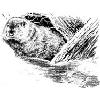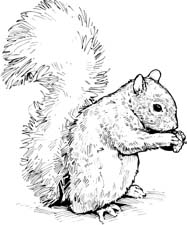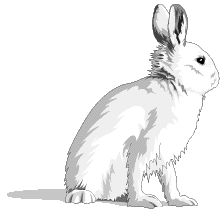DOES THIS ANIMAL REALLY NEED HELP?
- Be certain the animal is injured or orphaned, watch and wait before taking any action.
- With species such as deer and rabbits, the mother may be nearby.
- If it is a feathered young bird hopping on the ground, watch to make sure mother is around.
- If a bird has fallen out of a nest and you can get to the nest, pick up the bird carefully and put it in the nest.
- If a bird hits a window, check it for signs of injury such as bleeding, head tilt, broken wing, etc. If it appears to only be stunned, put it in a box and wait for 2 to 3 hours. At the end of that time see if it will fly away.

TAKE PRECAUTIONS FOR YOUR SAFETY AND THE ANIMAL'S!
- Handle birds and baby mammals with a towel or lightweight jacket. Placing a towel over a bird will calm it.
- Watch for beaks and claws and do not attempt to handle raptors such as hawks and eagles by yourself.
- Birds, such as herons, with long, pointed beaks will use their beaks as spears.
- Birds and mammals can carry diseases or parasites which can be transmitted to humans, but in most cases safe handling techniques will prevent that.
- If you are handling raccoons, skunks, woodchucks (groundhogs), or bats, wear heavy gloves if possible.

PREPARING TO TRANSPORT TO A REHABILITATOR.
- Place the animal or bird in an appropriately-sized cardboard box with padding inside (multi-layers of white paper towels, or a soft towel or washcloth without holes or strings) and air holes for ventilation. You can also use a pet carrier but remember to thoroughly disinfect it after transporting the wildlife to a facility before using it for your companion animal.
- Keep box in a warm, dark, quiet place until ready to transport to a rehabilitator.
- Do not give any food or water as the animal could drown, die from shock, or have problems with the wrong food.
- Keep all wild animals away from children and family pets.

WILDLIFE MYTHS
- If you touch a baby bird or baby bunny, the mother will reject or kill it.
Mothers will not reject their young but many baby wild animals have no body odor and predators cannot smell them. If you handle a wild baby, you put your smell on it and a predator may detect it, get curious and find the baby and eat it.
- I found a baby rabbit and the mother has not come back.
Mom usually only feeds 2 or 3 times during the night and only for short periods of time, this is to keep potential predators away. She built the nest, delivered the litter and has been caring for them without being observed. She will continue to do so. If you are not sure, take a piece of yarn and make an "X" over the nest before evening. Check the nest the next morning to see if it has been moved.
- A baby deer alone in the woods is an orphan.
The mother doe does not stay near her baby very long so her smell does not attract predators. But she is nearby and watching, even if you don't see her.
- If you see a night predator out during the daytime, it is rabid.
Not always. If a mother has babies in the den she may be hunting. Also animals can be routed from their den accidentally. You should never approach any wildlife though, especially if it's behavior is uncharacteristic.
- An animal carries rabies for 10 days then dies.
Animals and humans can carry rabies for up to/over 1 year. The disease becomes active and transmissible when the virus enters the brain and saliva. This stage last approximately 10 days and once it reaches this final stage, is always fatal.
- Rabies shots are given in the stomach.
Not any more. They are given in the large muscle tissue of the upper arms, legs and buttocks.

KEEPING WILDLIFE AS PETS - A CRUEL CHOICE!
- Wild animals do not make good pets - period!
- Even the "tamest" animal is unpredictable and can attack you.
- The constant stress of captivity will weaken the animals immune system, resulting in disease and often death.
- Many wild animals harbor disease and parasites that can be transmitted to humans and domestic pets.
- When a wild animal kept as a pet escapes, it's "tame" behavior is often viewed as a disease and may be picked up and destroyed by animal control officials.
- When an imprinted wild animal escapes, it may succumb to a horrible ending due to the lack of fear from humans and predators. For example if raised with humans, dogs and cats it will not view them as harmful and when the imprinted wild animal is confronted with one, it will not try to escape a potentially dangerous situation and become a victim.

WANT TO RAISE IT YOURSELF OR
THINK IT WILL BE A GREAT EXPERIENCE FOR YOUR CHILDREN?
- Wildlife can transmit diseases to you, your children and your pets.
- Wild animals need special experienced care. They require specific needs for nutrition, housing and socialization.
- All wildlife animals are protected under state or federal laws or both.
- If you want to teach your children about wildlife by caring for those baby bunnies or that nest of birds, most likely the only lesson they will learn is about suffering and death.
- Wild animals raised alone become "imprinted" on humans. They will not recognize their own kind and will never breed. They are never quite wild and never quite tame, being caught in a limbo that offers nothing except frustration, rejection and confusion.
- By the time you realize your efforts are failing and you do seek a rehabilitator's help, it is usually to late for them to save the animal.

|











